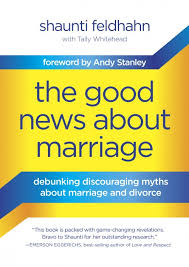 Shaunti Feldhahn with Tally Whitehead, The Good News about Marriage: Debunking Discouraging Myths about Marriage and Divorce (Colorado Springs, CO: Multnomah Books, 2014). Hardcover / Kindle
Shaunti Feldhahn with Tally Whitehead, The Good News about Marriage: Debunking Discouraging Myths about Marriage and Divorce (Colorado Springs, CO: Multnomah Books, 2014). Hardcover / Kindle
Marriage survives by hope. If a husband and wife believe that their relationship can get better, chances are that it will. They may have to tread a difficult path for a time, but eventually, the road becomes smoother and they arrive at their destination: a fulfilling life together.
Unfortunately, many of the statistics about marriage and divorce that are prevalent in our culture destroy hope. Fifty percent of all marriages end in divorce, we’re told. For second and third marriages, the divorce rate is even higher: 60 and 73 percent, respectively. Few couples are satisfied with their marriages. Though Christians talk a good game about marriage and family, the reality of divorce and dissatisfaction is the same for them as for everyone else. Finally, making a marriage work requires bigger changes than most couples are willing to make.
The funny thing about these hope-destroying statistics is that they’re wrong, misleading, or both. Instead, as Shaunti Feldhahn and Tally Whitehead argue in their new book, there’s plenty of good news about marriage. Indeed, they identify five specific pieces of good news:
- The vast majority of marriages last a lifetime; the current divorce rate has never been close to 50 percent—it is closer to 20 to 25 percent for first-time marriages and 31 percent for all marriages—and has been declining for years (p. 39).
- The vast majority of marriages are happy (around 80 percent)! Most people are glad they married their spouse and, given the chance, would do it all over again (p. 61).
- The rate of divorce in the church is 25 to 50 percent lower than among those who don’t attend worship services, and those who prioritize their faith and/or pray together are dramatically happier and more connected (p. 86).
- The large majority of remarriages last. Among women in second marriages, 65 percent are still married to their spouse, and of those who aren’t, many are widowed rather than divorced (p. 101).
- In most cases, having a good marriage or improving a struggling one doesn’t have to be ultra complicated or solve deep, systemic issues; small changes can and do often make a big difference (p. 117).
The authors recognize that getting good statistics about marriage and divorce is not an easy undertaking. Different studies ask different questions. The sample is occasionally not representative. The data sometimes point in different directions. And not all family scholars agree on conclusions.
Nevertheless, Feldhahn and Whitehead make a reasonable case for their conclusions, drawing on the best experts in the field and the best studies. Those wishing to investigate for themselves can read the authorities cited in the footnotes for themselves and draw their own conclusions. My guess is that they’ll come away convinced that Feldhahn and Whitehead are substantially correct.
Who, then, should read this book? Although drawing on social science research, this is not a social science book. Instead, it uses good research to help couples, marriage counselors, and Christian leaders better prepare themselves and others for lasting, fulfilling marriages. This hope-filled approach is helpful, for as the authors say, “‘You can believe in marriage’ can become the new normal” (p. 124).
Let’s hope so!
P.S. If you found my review helpful, please vote “Yes” on my Amazon.com review page.
P.P.S. For more good news about marriage, as well as practical advice for making your marriage good, visit http://www.shaunti.com.


2 thoughts on “Review of ‘The Good News about Marriage’ by Shaunti Feldhahn with Tally Whitehead”